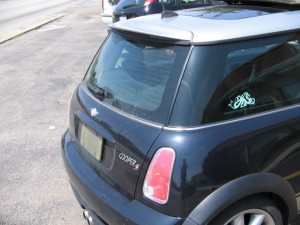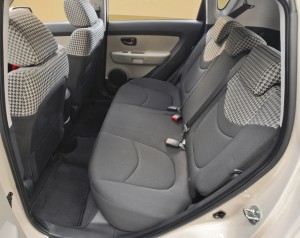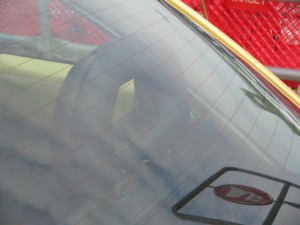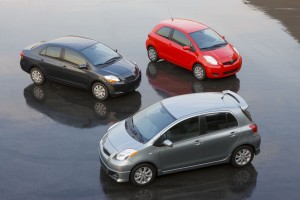Rear-end collisions, when a usually stopped car is struck from behind by a careless driver, are made to order for plaintiff lawyers.
They are, in the total mix, rarely fatal but can lead to painful neck and spine “whiplash” injuries with attendant claims. These are hard to defend because the cause is obvious, even though the problem is that such injuries are hard to either prove or disprove and many are suspected of being fraudulent.
Nevertheless, noise about whiplash injuries has led to some 40 years of vision-impairing head restraints in our cars under Federal motor vehicle safety standards.
In the real world, rear-enders are not a significant source of fatal injuries (unless of course, it is you or one of your loved ones who’s the victim). In 2008, according to NHTSA numbers derived from FARS reports, there were a mere 1,187 rear-end car crash deaths, out of the total fatal accidents of 37, 261 reported.
This low number likely will change for the worse if the new influx of minicars to the American marketplace continues unabated and unregulated. So far, the minicar segment amounts to a tiny share. In he first six months of 2009, total sales of those I count as mini came to only 148,889, or just 4.7% of the market. And all were down significantly from year-before sales.
My list of minicars includes the Smart ForTwo, BMW Mini, Chevrolet Aveo hatchback, Toyota Yaris hatchback, Honda Fit hatchback and the new Kia Soul hatchback. Even the larger VW New Beetle appears to offer insufficient rear crush space behind the rear seat.
Outside the U.S., such tiny vehicles amount to a greater share of the market. But outside North America, they are not overwhelmed in the traffic flow by the proportion of big pickup trucks, SUVs, vans and considerably heavier passenger cars. So our traffic is inherently more dangerous to tiny cars, leaving rear crush distance aside.
Instinctively, just about everyone understands the basic principles of physics: mass and weight overwhelm the shrimps of the roadway. And indeed today’s minicars are generally well equipped with airbags, so they tend to “pass” NHTSA and IIHS staged front- and side-crash tests and Consumer Reports ratings.
My concern lies with the small crush distance between the rearmost part of minicars and the head positions of rear passengers. It’s mere inches, as can be seen from any view by a casual observer or in the accompanying photos. A rear occupant of these tiny hatchbacks is virtually doomed to become the “first person at the crash.”
Even the popular VW New Beetle is not immune from this criticism. In fact, it was such a vehicle in front of me at a stoplight with small children in the back seat that first drew my attention to the danger. So, in my opinion, having your little ones seated in the back of a minicar hatchback is exposing them to unnecessary danger.
I guess I’m the only one out there who is wringing his hands over this issue, though. I asked both NHTSA and IIHS if they had any adverse case histories of minis being rear-ended or if they had conducted or planned to conduct rear-crash tests. Both answered “No.” And the Trial Bar likewise, as nearly as I can tell from the lawyers’ website “car-accidents.com (basically a directory of whiplash litigators), has not risen to the opportunity either.
Instead, NHTSA regulatory rear-end crash attention has been focused mainly on the head restraints, center high-mounted brake lights and high-tech means of automatic braking; IIHS on physical damage to bumpers and sheet metal in low speed accidents, and lawyers in collecting on whiplash injuries from careless drivers of the vehicle behind. No one seems to be paying any attention to crush distance, something that in this kind of crash, it is unlikely that any amount of air bags could alleviate.
It is a clear case of environmental concerns—demands for greater fuel economy and reduced emissions—out-pointing safety concerns.
It is interesting to note that several of the brands identified above also offer standard small sedans, with humpbacks for sizeable trunks behind the rear seat, so they have as much requisite crush space as one could reasonably expect. These include Aveo, Yaris and Fit. But their hatchbacks, in my view, are dangerous, especially for the young children likely to be riding in the back seat. Obviously, any car struck from the rear at high speed, especially by a much heavier bullet vehicle, can’t provide much protection, though more structure helps.
What can you do, as a parent of young ‘uns’? Avoid cars that are too small, or if economics forces you into the mini segment, avoid the hatchback models.
What can you do, as a driver, to avoid the potential tragedy of banging into the car ahead? The age-old advice is maintaining ten feet distance from the car you are following for every ten miles per hour of speed. In the Toronto area, on the Canadian version of Interstate highways, arrows painted on the pavement help you maintain this distance according to the posted speed limit. At the Ontario top speed limit of 100 kmph or about 62 mph, this means a marker on the pavement every 60 feet. Maintain that distance and presumably you can stop in time.
The problem with this is the guy who’s always in a hurry, so he cuts into your safe space from another lane. I don’t know of a way to prevent this except patience. On the other hand, keeping an eye on the traffic some distance and vehicles ahead also provides advance warning of sudden stops. This isn’t always possible either when you’re behind an SUV, van or oversized pickup, but it’s something I practice. And in more than 60 years of careful but often aggressive driving, while I’ve been rear-ended four times, I have never rear- ended a vehicle ahead.
Auto safety, auto accidents, Rear-end collisions, Mike Davis, TheDetroitBureau.com, NHTSA FARS reports, Smart ForTwo, BMW Mini, Chevrolet Aveo hatchback, Toyota Yaris hatchback, Honda Fit hatchback, Kia Soul hatchback, New Beetle,





Mike,
I am sure your concern for the safety of rear seat occupants in minicars when struck from behind is very sincere. But you are basing your concern on appearances, not facts.
As you have mentioned, rear end impacts are responsible for a very small percentage of fatal accidents…even when the striking vehicle is quite a bit larger than the vehicle which is hit. Why is that? There are two aspects of rear end collisions which favor the mitigation of accident forces…without even considering the design of the vehicle itself.
The first is that when you are rear ended, even if you are sitting still, your vehicle and the striking vehicle are essentially pointed in the same direction. Most of time you are stopped your foot is on the brake just enough to stop your car from creeping forward, so an impact from behind will cause your car forward, disapating a large part of the energy of the crash.
Second, the occupants of the vehicle which is hit will absorb the crash energy across their entire back. This is much greater surface area than the webbing of a seat belt, so the spot loading on the body is much lower than it would be in a frontal crash.
Finally, in modern cars there are real head restraints on the seat backs, not just head rests. They are designed to help limit the hyper extension of the neck, not just provide a place to lean your head back on long trips. Some cars, like Volvo, SAAB, and BMW even have specific anti-whiplash seat designs.
I agree that the proximity of a rear passenger’s head to the glass can be disturbing in minicars, but rest assured that designers have worked to see that these occupants are well protected for the vast majority of accident situations. This may sound like a bit of weasel wording, but there is no vehicle in the world which can literally guarantee you will never get hurt in any kind of an accident. Having said that, I simply remind you not to confuse how things look to you, versus safety parameter which have been scientifically established.
If you are not comfortable with putting your loved ones in a minicar, do yourself a favor, buy something else.
I’m glad to see that my column drew intelligent comment. As I pointed out, there is no data on minicar rear-enders, but it seems obvious to me that it is not a good thing to have the back window three or four inches from an occupant’s head, head restraints designed for whiplash in minor bumps not withstanding. Occupants are protected from side impacts in most modern cars by side bags.